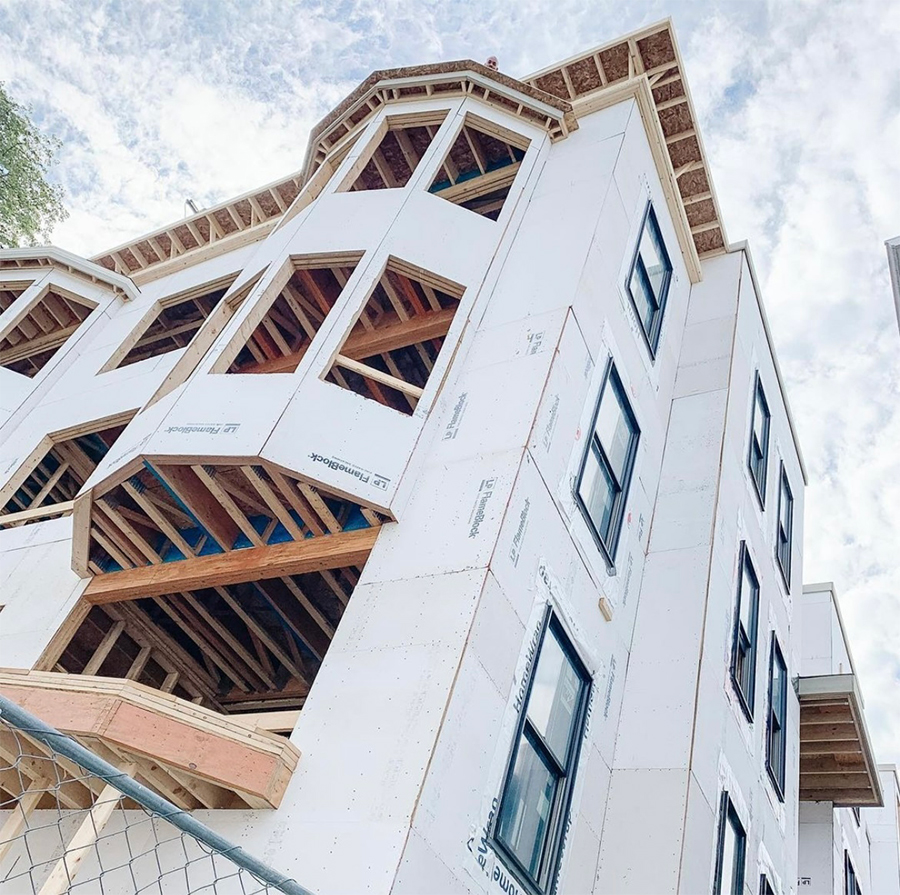Business Advice6 min
Horizontal Property Regimes: How to Help Prevent Row Home Fires
The trend to live near downtown hasn’t waned in recent years. However, finding empty lots to construct new houses continues to pose a challenge. Builders are finding solutions within the Horizontal Property Regime (HPR) zoning policy, which allows tall and skinny row homes.
However, with as little as six feet between structures the potential for row home fires dramatically increases. Let’s take a look at some of the concerns for both builders and homeowners—and how LP® FlameBlock® Fire-Rated Sheathing can help builders meet code.
What is a Horizontal Property Regime?
By definition, Horizontal Property Regimes allow the construction of two houses on one parcel of land. Traditionally HPRs required units to be connected or stacked on top of one another, similar to typical duplexes and condominiums. Today, HPR zoning has paved the way for tall and skinny row house construction.
Each state has laws defining and governing the specifics of horizontal property regimes. Typically, however, the property owners—or in many cases the builders—must create and record a master deed that outlines details of the regime, including ownership, maintenance and authority. HPRs are very similar, in fact, to condominium HOAs.
What are the Differences in a Horizontal Property Regime vs. a Condo?
HPRs for row houses are very similar to condominium zoning. By definition, condos refer to “common ownership.” While different homeowners own each unit, areas such as pools, halls, stairways, sidewalks and roofs are owned “in common,” and the expenses to maintain or repair them are shared among the owners.
For horizontal property regimes, common ownership extends to fire risk and potential fire damage as fire can quickly spread and engulf a row of tall and skinny houses.
When Do I Need Rowhome Fire Protection?
With as little as six feet between row houses, it can be difficult for firefighters to get between the structures and fight back the flames. As HPR zoning codes are evolving with urban infill, building codes are also adjusting.
Building codes typically require exterior fire-resistance-rated wall assemblies when the fire separation distance becomes small. The fire separation distance is defined in the code as the shortest distance between a building and the lot line or to an imaginary line between two buildings on the same lot.
For example, row homes with only six feet between them have only a three-foot fire separation distance. Since this is less than the minimum five feet of fire separation distance required (without sprinklers), the exterior walls must be 1-hour fire-resistance-rated, with the rating from either side.
The exterior rating provides thermal protection for the neighboring house, and the interior rating works to keep the fire contained in the burning house as long as possible. This requirement changes if there is more than five feet of fire separation between neighboring homes or if the homes are sprinklered. For specific requirements in your area, be sure to check local building codes carefully.

LP® FlameBlock® Fire-Rated Sheathing is especially beneficial in the construction of low- and mid-rise wood structures like tall and skinny row houses. LP® FlameBlock® panels combine flame-spread and burn-through resistance with the structural capacity of OSB sheathing in a single panel, helping reduce damage among HPR-zoned row houses situated on one lot.
To make LP® FlameBlock® fire-resistive panels, LP’s proprietary ignition-resistant, fiberglass-reinforced Pyrotite® coating is applied to the OSB panels. The sheathing allows fire resistance–rated walls to be assembled faster than common alternatives, potentially reducing labor costs while providing exceptional strength, durability and consistency.
Meeting code is just one of the benefits of LP® FlameBlock® Fire-Rated Sheathing. For more information on these innovative assemblies, review our complete guide.

Continue Reading
News & Stories3 min
History of Partnership with Gary Sinise Foundation
The LP Foundation is a proud partner of the Gary Sinise Foundation, which supports wounded veterans in several ways. You can learn more about the LP Foundation here.
Business Solutions
4 minQ&A: How Home Orientation Impacts Continuous Insulation
There’s a lot to consider when it comes to building an energy-efficient home for your clients and the many nuances that change with each build—including its orientation to the sun. We sat down with Neil Freidberg, Building Science Manager at LP, to unpack the impact of home orientation on continuous insulation needs.
Resiliency Solutions
5 minHOW A RADIANT BARRIER CAN IMPROVE BURIED DUCT PERFORMANCE
One of the questions LP® Building Solutions gets from builders often is about burying ducts in attic insulation and whether combining radiant barrier sheathing with blown insulation over ductwork can benefit homeowners. As with most technical situations, the outcome depends on a nuanced approach. Let’s dig in and explore this question.
Sustainability Solutions
8 minHow to Drive Effective Communication and Collaboration on the Jobsite
Every jobsite has a ton of moving parts, from product shipments, supplies, and schedules to subcontractors and homeowners. It’s no wonder that many project teams can struggle to maintain quality jobsite communication and collaboration throughout the building process. And when communication slips, construction companies inevitably deal with costly errors, inefficient workflows, delayed projects, or wasted time, leaving clients and the team frustrated.